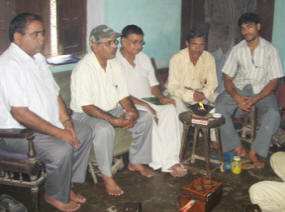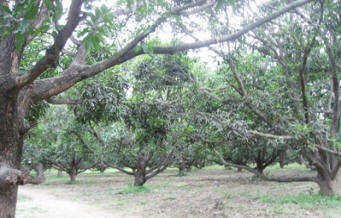|
Vyahruti Homa with Mr. R.K. Mishra,
Director of Horticulture in the District Unnao, Dr. R.A. Ram, senior
Scientist in the Subtropical Horticulture Institute in the city of Lucknow, Mr. Ramesh Chandra Tiwari, owner of the farm, Mr. Raj Kumar
and his son Akilesh Awasthi, who are in charge of performing the
healing Homa fires on this farm. |
The Homa farm of Mr. Ramesh Chandra Tiwari
has set an example in the area of this district, called Unnao. This farm
is free of plagues and diseases and has an excellent production. In a
short time several more Homa Resonance points have been established in his area
and will help more farmers to achieve a healthy, abundant and economic
harvest. All this was possible through the help and
support of Dr. R.K. Pathak and his team. |
|
Farmer Ramesh Chandra
Tiwari
Village: Khanpursirauli, Post: Hasanganj, District: UNNAO, U.P., INDIA
Mr. Tiwaris' life has changed since he started with Homa Therapy on his
12 acre farm three years ago. His farm, like all the others, suffered
under diseases like Powdery Mildew, and plagues like the Mango hopper and
Mealy bug. He spent approx. 5,000 (five thousand) Rupees on
pesticides on one acre of mango orchard before he began with Homa Therapy.
(The salary of a worker is between 50 and 80 Rupees a day.) The harvest
decreased every year, and the prices and frequency of the agrochemical
applications (pesticides and fertilizers) was rising. The taste of these
mangos was not good.
His father started the farm 50 years ago and that is also the age of the
mango trees, variety Dashahari, which still can produce another 10 to 15 years,
he says.
Now, he has an excellent mango production. They are large in size,
sweet, tasty. They weigh between 500 to 900 grams. Total production in
his land this year was 40 tons of mangos, which means 120 to 130 kg of
mangos per tree. Mr. Tiwari tells us also, how he experienced
an increase of production
with the use of Biosol Homa.
He further lets us know that there was a certain, very difficult weed in
his mango orchard, called “Gadaula”, with which his father was
fighting without success. After starting Agnihotra, this weed
disappeared by itself.
Something makes him very happy, he tells us, it is, that he just
retired from being the director of a nearby school and now "I will be
able to do all the Homa fires myself. I look forward to this very much."
He has seen the health of his workers improve on all levels and also the
human interactions have become smooth. He says that Agnihotra ash
removes depression and that a new motivation comes.
click here to see Mr. Tiwaris Testimony (in Hindi)
|
|
Everyone else
had very low production with small mangos this year, fighting with plagues and
diseases: |
|
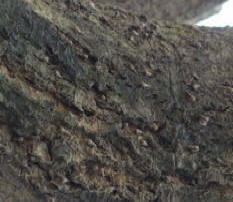
Mango hoppers on the bark
of a mango tree. |
Mango hopper:
Mango hoppers are found throughout the year hiding under the
bark or leaves. Of all the mango pests, hopper is considered
as the most serious and widespread pest throughout the country.
Large number of nymphs and adult insects puncture and suck
the sap of tender parts, thereby reducing the vigor of the
plants. Heavy puncturing and continuous draining of the sap
cause curling and drying of the infested tissue. They also
damage the crop by secreting a sweet sticky substance which
encourages the development of a fungi
commonly known as sooty mould which affects adversely the
photosynthesis of the leaves.
Integrated Pest Management (IPM)
officially suggests |
|
and informs the farmers
in case of Mango hoppers: The continuous use of pesticides though control
the pest but pose some other serious problems like killing of
pollinators and natural enemies, development of resistance to
insecticides and residues which are on fruits hazardous to human
population. Besides, the high cost of pesticides, labour and
maintenance of equipments are other limiting factors in pest
control. |
|
Powdery mildew
(Oidium mangiferae Berthet): Powdery mildew is one of the
most serious diseases of mango affecting almost all the
varieties in many African countries, south of the Sahara,
the middle East, Southern Asia and America from the Southern
United States to Peru and Brazil. The disease is reported to
cause approximately 20% crop loss in Maharashtra state alone.
Sometimes as high as 70-80 per cent crop loss has been recorded
on individual plant basis. The affected flowers and fruits drop
pre-maturely reducing the crop load considerably or might even
prevent the fruit set. |
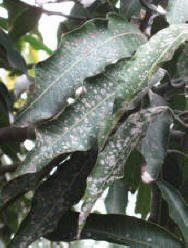 |
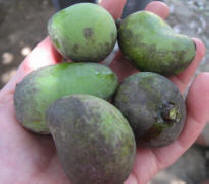
Harvest of
Small and diseased Mangos due to pests and diseases even with
huge input of pesticides.
This is catastrophic for the small farmers, since this is their
only livelihood. |
|
